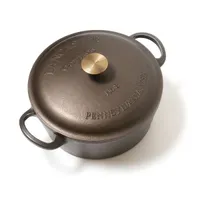This Dutch Oven has become a workhorse in my kitchen — and it's $75 off for Black Friday
The Lancaster 5-quart Dutch Oven can do it all

When it gets cold out, I get a lot more use out of my dutch ovens, as I use them for baking bread, braising meats and cooking up batches of stews and soups.
Typically, I've relied on a well-loved enameled cast iron dutch oven for these tasks, but Lancaster Cast Iron sent me its new 5-quart Dutch Oven to try out, so I was curious to see how it compared. It's quickly become my go-to dutch oven, and even better, it's now $75 off for Black Friday.
The Lancaster 5-Quart Dutch oven has a diameter of 10.5 inches, a wall height of 4 1/8 inches, and weighs 13 pounds. It has a polished interior surface and comes with a lid.
Price check: $299 at Amazon
The Lancaster Cast Iron Dutch Oven has a diameter of 10.5 inches and a wall height of 4 1/8 inches. It weighs 13 pounds.
By comparison, the 5.5-quart Le Creuset Signature Dutch Oven is slightly narrower at 10.25 inches in diameter, but a touch higher, at 4.5 inches. It's also lighter, at 11.25 pounds.
Lancaster's Dutch Oven is all cast iron, save the polished brass knob on the lid, which makes for a nice pop of color amid the sea of pewter gray. Lancaster's logo — a Conestoga wagon — is etched on the knob, and imprinted on the underside, too.
The Dutch Oven comes pre-seasoned, and like Lancaster's other cast iron products, the interior is polished smooth. I also liked its large handles, which made it easy to hold and pull in and out of my oven.
Lancaster 5-quart Dutch Oven: price
The Lancaster 5-quart Dutch Oven regularly costs $299, and is available on the company's site. That's $120 less than the regular price of a similar-size enamel Le Creuset Dutch Oven, though it should be noted that this model is currently just $329. However, Lodge sells a six-quart enameled cast iron Dutch Oven for just $79 on Amazon.
Lancaster 5-quart Dutch Oven: Performance

To test the Lancaster Dutch Oven, I first baked a loaf of the New York Times' no-knead bread; I heated it to 450 degrees F, then dropped in the dough. About an hour and a half later, I had a wonderfully fragrant loaf of bread with a beautiful crust.
I then roasted a chicken, placing root vegetables like carrots and potatoes at the bottom. This was a bit less successful, as I was hoping that the vegetables would sear a little on the bottom of the pot, but instead, the juices released by the chicken made a bit of a soupy mess. Still, the chicken came out plenty moist.
Later, I braised some beef shanks with onions, carrots, and mushrooms. After several hours, the meat was fork-tender and succulent, and went well with the mashed potatoes I made on the side.
Last, I also used the Dutch Oven to fry up a batch of meatballs for my Sunday Gravy; the pot did an excellent job of both browning the meat and keeping the oil from splattering out onto my counter.

Enameled vs. non-enameled cast iron dutch ovens

One advantage of a non-enameled Dutch Oven is that you don't have to worry about it chipping; all of my enameled Dutch Ovens show signs of wear, specifically around the rim where the enamel ends.
However, an enameled Dutch Oven gives you a little more flexibility in what you can cook, especially when it comes to acidic foods such as tomato-based sauces, which can strip the seasoning out of cast iron. Lancaster says that, even though its Dutch Oven is pre-seasoned, you should cook it with some oils and fatty foods, like sausage and bacon, the first few times to better build up the seasoning.
I found this out the hard way; the second time I used the Lancaster, I cooked a whole chicken with some root vegetables at the bottom; while I had coated the potatoes in olive oil, they still managed to remove a bit of the seasoning from the bottom of the pot. Ah well — I'll take any excuse to fry up some bacon.
Get instant access to breaking news, the hottest reviews, great deals and helpful tips.

Michael A. Prospero is the U.S. Editor-in-Chief for Tom’s Guide. He oversees all evergreen content and oversees the Homes, Smart Home, and Fitness/Wearables categories for the site. In his spare time, he also tests out the latest drones, electric scooters, and smart home gadgets, such as video doorbells. Before his tenure at Tom's Guide, he was the Reviews Editor for Laptop Magazine, a reporter at Fast Company, the Times of Trenton, and, many eons back, an intern at George magazine. He received his undergraduate degree from Boston College, where he worked on the campus newspaper The Heights, and then attended the Columbia University school of Journalism. When he’s not testing out the latest running watch, electric scooter, or skiing or training for a marathon, he’s probably using the latest sous vide machine, smoker, or pizza oven, to the delight — or chagrin — of his family.

